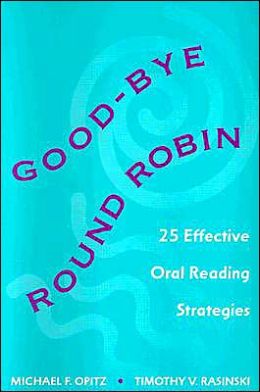First, keep in mind that all of the methods listed here are quite do-able when the students are trained in them. They are most effective when you train students in one method completely before you teach them a new method. These methods result in higher comprehension than round robin reading.
Staggered: Teacher designates one student at a time to begin (on page 1) whisper reading. The teacher listens in for a short time. Then, the teacher designates the 2nd student to start whisper reading on page 1. Eventually, all the students in the circle start at different places. I use this with 1st through 4th graders. Listening in is VERY important. This is where I get the best anecdotal notes that help guide my teaching.
Shared:
Teacher reads aloud, modeling good fluency and intonation, while
students follow along in their own copy of book. Teacher frequently stops and
models comprehension strategies and skills such as inferencing, drawing
conclusions, questioning, connecting, cause & effect, picturing,
summarizing, evaluating, etc., but not so frequently as to interfere with the
flow of the story.
Independent:
Students read independently, are assigned clear stopping and starting
points, and a purpose for reading (“While you read, look for…” “While you read,
think about how…” “While you read, see if you can figure out why…” etc.) Try an Anticipation Guide (see attached) so
the reader can compare his thoughts and opinions about the topic to the writer’s
message as they read or the teacher can choose to have students respond in
response journals when finished reading or respond to prepared higher level
questions in their journals. Faster
readers then are not held up by the slower readers like they are in round robin
reading.
Jigsaw: Works
very well with content area reading (ss, science) and text with subheadings.
Assign sections of reading, split kids into different groups, assign a section
of text to read, and assign jobs (clear and limited) so they can teach the
other groups the content of their assigned section. Each group becomes the expert on their
section of text in order to teach the other groups. Teacher must decide on which graphic
organizer is most appropriate for groups to create and use to synthesize their
information and teach other groups.
Other groups should be learning, taking notes, asking questions as
teaching group teaches in order to glean the information from them. Teacher must model first how to both learn
from a teaching group and how to teach when you are the teaching group.
Paired
(“Buddy”): This is not just pairing up two students to
read aloud to each other, this is training the students to follow the buddy
reading strategies (see attached.). Students must be taught how to be the
“teacher” and how to be the “student.”
Set expectations and guidelines for reading work, behavior, etc. This is very effective and enjoyable for the
kids. Teacher sets a purpose for
reading, assigns a clear goal, clear starting and stopping points, what to do
when finished reading (continue to work on graphic organizer started in
pre-reading, answer questions in response journals, respond to text in other
form, make a graphic organizer to show knowledge gained to other groups, etc.)
Reciprocal:
Initially teacher directed, gradually teacher drops level of support so
that it is student directed. Purpose is
to make reading techniques that good readers use visible to all students. Students need to internalize that they need
to do these things in their heads with everything they read. Good readers use all of these steps, although
they are not always visible.
·
Predict
·
Read
(can be shared in beginning, or whole class)
·
Question,
clarify points of uncertainty
·
Summarize
(to teach students to synthesize information gained in reading and give it back
in their own form)
For content area
reading, read all subheadings separately using all 4 steps in each
subheading. For fiction, read each
section of the text, using all 4 steps in each section.
***Please understand that all of these methods are excellent in their own unique way and it is important to know that they are used for specific purposes at specific times throughout the instructional process.
 ------> This is a great text that tells about many oral reading strategies.
------> This is a great text that tells about many oral reading strategies.
 ------> This is a great text that tells about many oral reading strategies.
------> This is a great text that tells about many oral reading strategies.
Thanks for reading!
~*Gina*~
"Any book that helps a child to form a habit of reading, to make reading one of his deep and continuing needs, is good for him."
- Maya Angelou
No comments:
Post a Comment